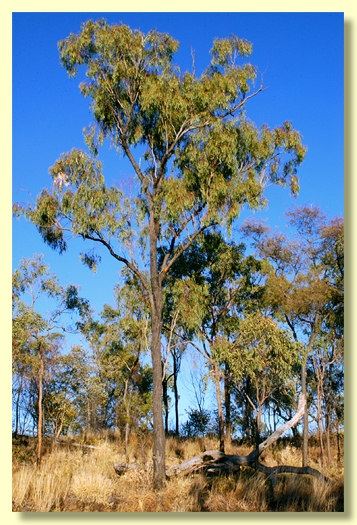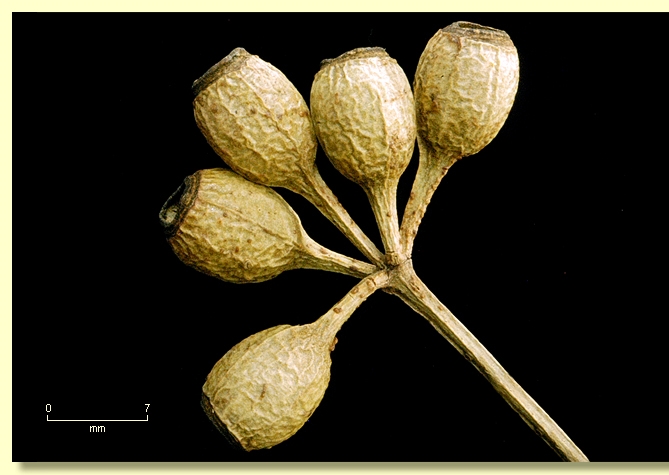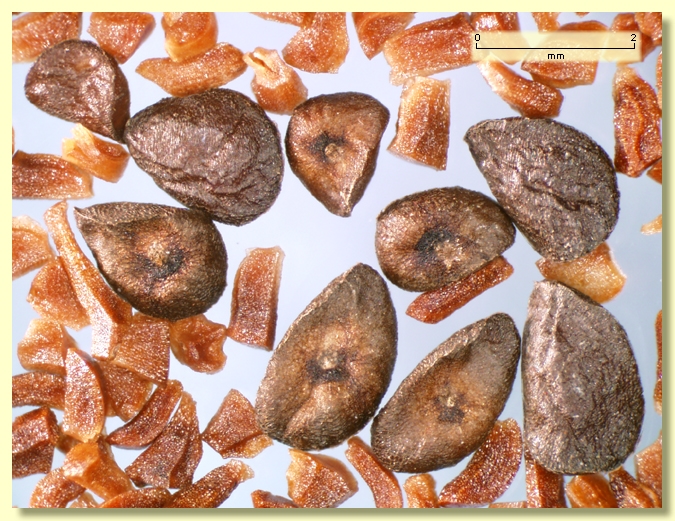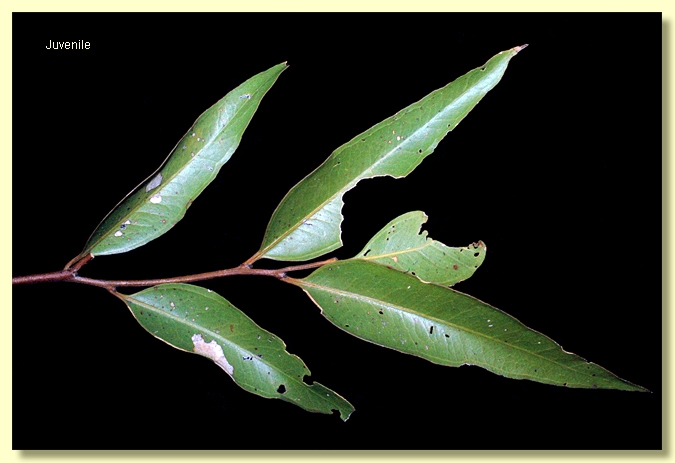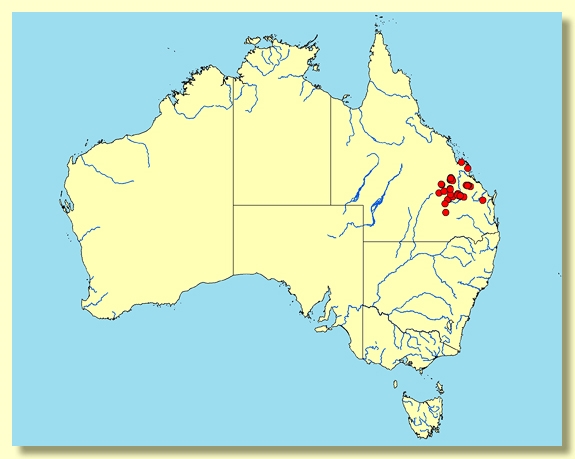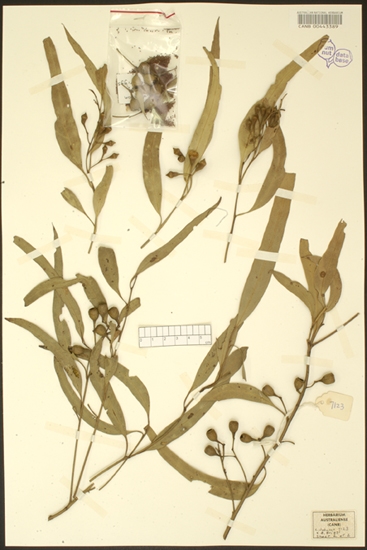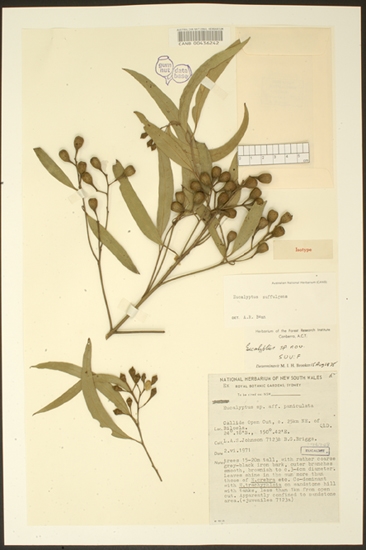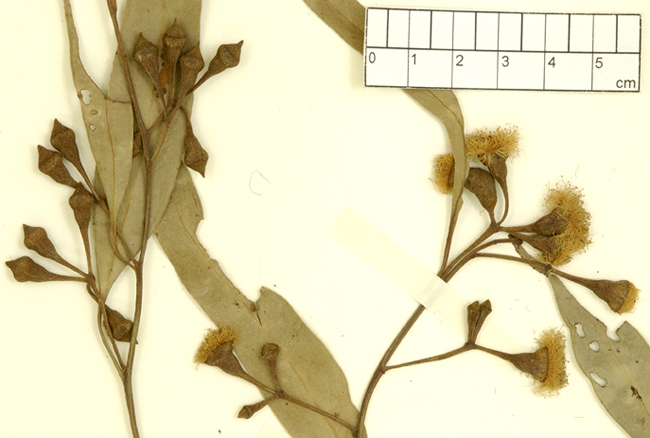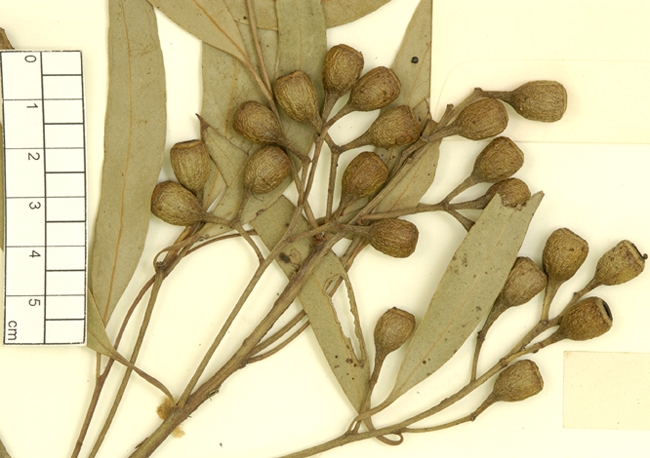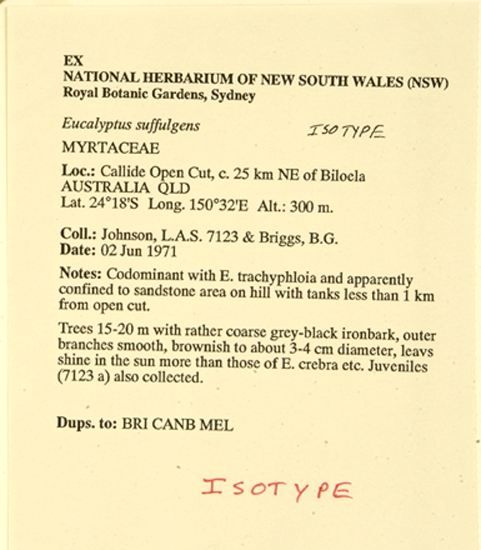Eucalyptus | Symphyomyrtus | Adnataria | Terminales | Rhodoxylon | Concolores
Euclid - Online edition
Eucalyptus suffulgens
Tree to 25 m tall. Forming a lignotuber.
Ironbark, dark grey to black. Branches c. 5 cm diameter or narrower often smooth-barked.
Oil glands sometimes present in the pith of the branchlets.
Juvenile growth (coppice or field seedlings to 50 cm): stem square in cross-section, not glaucous, smooth; juvenile leaves opposite for a few pairs, becoming alternate, sessile to shortly petiolate (petioles ca 0.5 cm long), ovate to lanceolate, 7–13 cm long, 0.6–4(4.6) cm wide, base tapering or sometimes oblique, apex pointed, glossy dark green, discolorous.
Adult leaves alternate, petiole 0.8–2(2.5) cm long; blade lanceolate, rarely falcate, 8–16(18.5) cm long, (1)1.5–2.5(3.4) cm wide, base tapering to petiole, concolorous to slightly discolorous, glossy, green, side-veins usually at an angle less than 45° to the midrib, sometimes slightly greater than 45° to midrib, densely to very densely reticulate, intramarginal vein parallel to and well removed from the margin, oil glands intersectional.
Inflorescence terminal compound, or axillary compound or sometimes axillary single in axils below this, peduncles (0.8)1–2(2.2) cm long, buds 7 per umbel, pedicels 0.3–1 cm long. Mature buds obovoid to pyriform, 0.7–1 cm long, 0.4–0.5 cm wide, rarely ovoid, scar present, operculum conical to rarely slightly beaked and narrower and much shorter than the hypanthium, stamens inflexed, with outer filaments lacking anthers (staminodes), anthers adnate, positioned obliquely at filament tip, cuboid, dehiscing by terminal pores, style long, stigma pin-head, locules 4 or 5, the placentae each with 4 vertical ovule rows. Flowers white.
Fruit on pedicels 0.3–0.9 cm long, barrel-shaped, rarely cup-shaped to almost cylindrical, 0.7–1.3 cm long, 0.5–1 cm wide, disc descending, valves 4 or 5, enclosed.
Seeds brown, 2–2.5 mm long, flattened-ovoid, shallowly reticulate, hilum ventral.
Cultivated seedlings (measured at ca node 10): cotyledons reniform to oblong; stems square in cross-section; leaves always petiolate, opposite for ca 3 to 5 nodes then alternate, linear to narrowly lanceolate to lanceolate, 8–15(16) cm long, 0.8–2.2 cm wide, base tapering, glossy green.
Flowering has been recorded in April, May, July, August and September.
A small to medium-sized ironbark tree endemic to south-east Queensland, preferring hills and ranges, from the Biloela area to the Byfield Range and Stanage Bay area just north of Rockhampton then west through the Blackdown Tableland – Expedition Range east of Rolleston – Carnarvon Ranges – Isla Gorge region as far south as the area just east of Mitchell. It is characterised by concolorous glossy green adult leaves, terminal inflorescences, buds with staminodes, barrel-shaped fruit with four or five valves and linear to narrowly lanceolate to lanceolate juvenile leaves.
Within its subgroup, i.e. subseries Concolores, E. suffulgens is very close to E. dura and differs only marginally by having slightly bigger fruit (0.6–1 cm wide for E. suffulgens and 0.5–0.7 cm wide for E. dura) and slightly narrower juvenile leaves (0.8–2.5 cm wide for E. suffulgens and 3–6 cm wide for E. dura). It must also be close to E. sicilifolia. Both species have relatively narrow juvenile leaves. E. sicilifolia differs by having smaller fruit (0.4–0.6 cm wide in E. sicilifolia and 0.6–1 cm wide in E. suffulgens). The only other members of the subseries Concolores with glossy green leaves similar to E. suffulgens are E. melanoleuca and E. virens. E. melanoleuca differs by having ovate juvenile leaves (linear to narrowly lanceolate to lanceolate in E. suffulgens) and E. virens has smaller hemispherical to obconical fruit (0.5–0.7 cm wide in E. virens and 0.6–1 cm wide and barrel-shaped in E. suffulgens). All other members of this subseries have dull adult leaves.
All the species in the subseries Discolores, i.e. E. paniculata, E. decolor, E. placita and E. sp. Dorsiventralis, differ by having distinctly discolorous adult leaves (E. suffulgens with concolorous to slightly discolorous adult leaves). E. sp. Dorsiventralis differs further by having four-sided fruit.
Within its area of occurrence there are other ironbarks which maybe confused with E. suffulgens. They are E. beaniana, E. crebra, E. decorticans, E. fibrosa subsp. fibrosa, E. fibrosa subsp. nubila, E. melanophloia, E. rhombica and E. tholiformis, all of which differ in having buds with stamens all fertile and irregularly flexed.
Eucalyptus sideroxylon differs by having buds that hold the outer operculum into maturity and both the inner and outer operculum shed together at anthesis (no operculum scar).
Eucalyptus suffulgens: Latin sub- (assimilated to suf before f), somewhat and fulgens, shining, referring to the somewhat glossy adult leaves.

